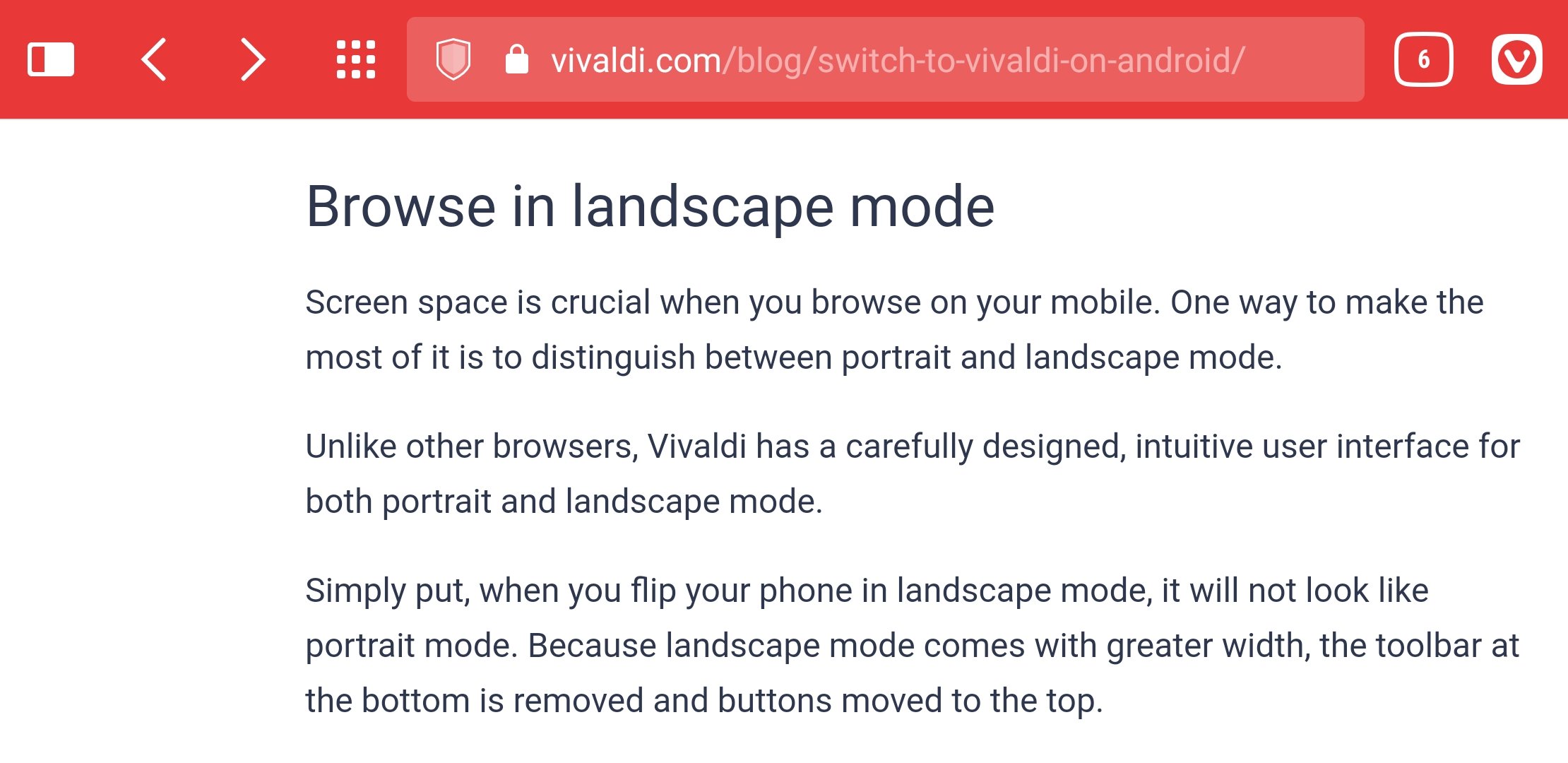Browser interface on Android
This post is also available in:
![]() 日本語
日本語 ![]() Русский
Русский ![]() Français
Français ![]() Español
Español ![]() Deutsch
Deutsch ![]() Nederlands
Nederlands ![]() Српски
Српски ![]() Українська
Українська ![]() Polski
Polski ![]() Български
Български ![]() 简体中文
简体中文
Like the desktop browser, Vivaldi on Android has a unique User Interface.
Tab Bar
On the Tab Bar, you can see all your open Tabs, just like on desktop. If you have a lot of Tabs open, swipe left or right on the Tab Bar to see the rest of the tabs.
To enable/disable the Tab Bar:
- Go to
 Vivaldi menu > Settings > Tabs.
Vivaldi menu > Settings > Tabs. - Toggle on/off Show Tab Bar.

To move the Tab Bar to the bottom of the screen together with the Address Bar:
- Go to
 Vivaldi menu > Settings > Tabs.
Vivaldi menu > Settings > Tabs. - Toggle on/off Address Bar At Bottom.
To fit more tabs on the Tab Bar by only showing the open websites’ favicons:
- Go to
 Vivaldi menu > Settings > Tabs.
Vivaldi menu > Settings > Tabs. - Toggle on Show Tab As Favicon.

By default, the close tab button on the Tab Bar has been hidden for background tabs. To show the close buttons for all tabs:
- Go to
 Vivaldi menu > Settings > Tabs.
Vivaldi menu > Settings > Tabs. - Toggle on Show X Button For Background Tabs.

Address Bar
 Site Info and Content blocker – check your connection security and access Site Settings, as well as change the tracker and ad blocking level for the website.
Site Info and Content blocker – check your connection security and access Site Settings, as well as change the tracker and ad blocking level for the website.- Address and Search field – type in the link you want to visit or a search term you want to look up.
 Reload – if you’ve scrolled too far down and swiping down to reload isn’t reasonable, you can tap on the Reload button.
Reload – if you’ve scrolled too far down and swiping down to reload isn’t reasonable, you can tap on the Reload button. Vivaldi menu – access options such as Bookmark Page, Capture Page, Settings, and much more by tapping on the Vivaldi logo.
Vivaldi menu – access options such as Bookmark Page, Capture Page, Settings, and much more by tapping on the Vivaldi logo.

To move the Address Bar to the bottom of the screen:
- Go to
 Vivaldi menu > Settings > Tabs.
Vivaldi menu > Settings > Tabs. - Toggle on/off Address Bar At Bottom.
In the place, where, by default, the Tracker and Ad Blocker button is, you can choose to put a different button that you find more useful.
To change the button:
- Go to Settings > Appearance & Theme > Toolbar Shortcut.
- Choose your preferred feature.
- Tracker and Ad Blocker,
- New tab,
- Share this page,
- Voice search,
- Translate,
- Add to Bookmarks.
Once you’ve added a shortcut, you can long-press on it on the Address Bar and select Edit shortcut to pick a different option or hide the button.
 Panels – access your Bookmarks, History, Notes and Downloads.
Panels – access your Bookmarks, History, Notes and Downloads. History back – move back in history of visited pages.
History back – move back in history of visited pages. Start Page – access your favourite bookmarks – Speed Dials.
Start Page – access your favourite bookmarks – Speed Dials. History forward – move forward in history of visited pages.
History forward – move forward in history of visited pages. Tab switcher – view all open, private, synced and recently closed tabs.
Tab switcher – view all open, private, synced and recently closed tabs.
The icons on the bottom Navigation toolbar will change when you view the Panels or the Tab Switcher to give you additional options.
In case you’ve moved the Tab and Address Bars to the bottom of the screen, the bottom toolbar buttons will be merged with the Address Bar. Due to limited space, some of the buttons will be moved to the ![]() Vivaldi menu. Though, you can enable the
Vivaldi menu. Though, you can enable the ![]() Start Page button from
Start Page button from ![]() Vivaldi menu > Settings > Appearance & Theme > Show Start Page Icon in Address Bar.
Vivaldi menu > Settings > Appearance & Theme > Show Start Page Icon in Address Bar.
In landscape mode and on larger screens, such as on tablets, all the icons from the bottom toolbar are moved to the top toolbar.

If you prefer to keep the Tab and Address Bars on top, but still want to hide the Navigation Bar:
- Go to
 Vivaldi menu > Settings > Appearance & Theme.
Vivaldi menu > Settings > Appearance & Theme. - Disable Show Navigation Bar.
Always show controls
When you scroll down on a page the toolbars will be hidden automatically to free up screen real estate. When you scroll up, the toolbars will be displayed again.
If you wish to keep the toolbars always visible:
- Go to
 Vivaldi menu > Settings > Appearance & Theme.
Vivaldi menu > Settings > Appearance & Theme. - Toggle on Show Toolbars While Scrolling.
Theme
To customize the browser colors, open the ![]() Vivaldi menu > Settings > Appearance & Theme > Theme and make your adjustments.
Vivaldi menu > Settings > Appearance & Theme > Theme and make your adjustments.
Dark mode for webpages
If, in addition to the app’s user interface, you also wish to view websites in dark mode, enable Dark mode for Web Pages from Theme settings.
In case some sites don’t look good in the forced dark mode, you can toggle it off for that particular website from ![]() Vivaldi menu > Dark theme.
Vivaldi menu > Dark theme.